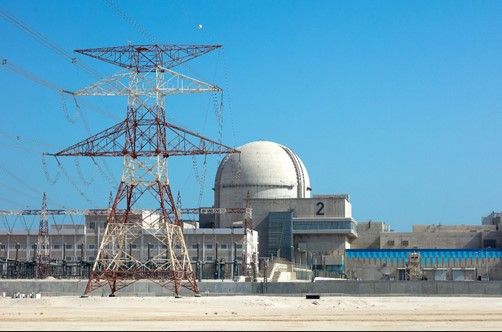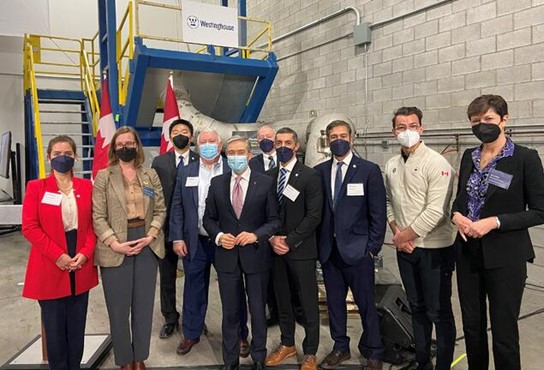A view of the village of Min Kush in central Kyrgyzstan. (Photo: EBRD)
The remediation of two former Soviet-era uranium mining sites in Kyrgyzstan has been completed on schedule and below budget, despite difficulties caused by the COVID-19 pandemic, the European Bank for Reconstruction and Development (EBRD) announced on March 28.
Unit 2 at the UAE’s Barakah nuclear plant. (Photo: ENEC)
Unit 2 at the United Arab Emirates’ Barakah nuclear power plant has entered commercial operation, Emirates Nuclear Energy Corporation (ENEC) announced on March 24. Unit 2 adds an additional 1,400 MW of zero-carbon emission electricity to the UAE’s national grid, bringing the total amount of electricity produced at Barakah to 2,800 MW.
U.S. undersecretary of state for arms control and international security Bonnie Jenkins (left) and Philippine energy undersecretary Gerardo D. Erguiza Jr. (center) sign a memorandum of understanding on nuclear cooperation at the State Department. Looking on (right) is Philippine ambassador to the United States Jose Manuel Romualdez. (Photo: Philippine Embassy, Washington, D.C.)
The United States and the Philippines recently signed a memorandum of understanding on strategic civil nuclear cooperation to help boost the development of the latter’s nuclear energy program.
The Palisades plant near Covert, Mich. (Photo: Entergy)
“Many states have made carbon dioxide–reduction plans with no hope of success. But if they want to meet even a portion of those goals, they must put nuclear power back on the table.” So opined Tim Cavanaugh, senior editor at the Mackinac Center for Public Policy, in an essay published by The Hill on March 23.
Aerial view of the High Flux Isotope Reactor. (Photo: ORNL)
The nonproliferation-related monitoring of nuclear reactor operations received a boost from a new study focusing on the use of seismic and acoustic data for such purposes, ScienceDaily reported last week. The study, conducted by investigators at Oak Ridge National Laboratory, was published March 9 in the journal Seismological Research Letters.
Sandia National Laboratories researchers Melissa Mills, left, and Kristopher Kuhlman peer through a WIPP salt sample.
Last fall, scientists from Sandia, Los Alamos, and Lawrence Berkeley national laboratories began the third phase of a years-long experiment to understand how salt and very salty water behave near hot nuclear waste containers in a salt-bed repository. Initiated in 2017, the Brine Availability Test in Salt (BATS) project is part of a spent nuclear fuel research campaign within the Department of Energy’s Office of Nuclear Energy (DOE-NE).
Czech prime minister Petr Fiala and ČEZ CEO Daniel Beneš (foreground, third and fourth from left, respectively). (Photo: ČEZ)
Cover of the April 1962 issue of Nuclear News (left), ATR core diagram appearing in October 1969 issue of Nuclear News (center), and cover of the October 1969 issue of Nuclear News (right).
The Department of Energy and Idaho National Laboratory announced this week that the sixth major core overhaul of the Advanced Test Reactor (ATR) is complete, after an 11-month outage that began in April 2021. The ATR was built as a key piece of mission support for U.S. Navy programs and first reached full power in 1969. Today it remains “the world’s largest, most powerful and flexible materials test reactor,” in the words of INL—quite a feat for a reactor that was planned over 60 years ago.
A cutaway image of the BWRX-300. (Image: GEH)
Wilmington, N.C.–based GE Hitachi Nuclear Energy has signed a memorandum of understanding with Kärnfull Next—a new company and a wholly owned subsidiary of Swedish firm Kärnfull Future AB—to collaborate on the deployment of GEH’s BWRX-300 small modular reactor in Sweden.
A screenshot of the panelists for the ANS spent fuel management webinar.
The Department of Energy’s new consent-based process for siting an interim storage facility for the nation’s spent nuclear fuel faces many challenges, but it could be successful if correctly implemented by the department, according to the panelists of the American Nuclear Society’s webinar “Spent Nuclear Fuel Management: Wasting Away or Chance for Progress?” ANS President Steve Nesbit moderated the webinar, held on March 23.
UCOR workers remove waste from the Alpha-2 building at the Y-12 National Security Complex in Oak Ridge. (Photo: DOE)
The Department of Energy recently awarded $24.7 million to Oak Ridge cleanup contractor UCOR for its work at the Oak Ridge site in Tennessee from April 2021 through October 2021, amounting to 98 percent of the available fee for the evaluation period.
François-Philippe Champagne, Canada’s minister of innovation, Science, and Industry (center, foreground), visited Westinghouse Electric Canada’s Burlington, Ontario, facility for the March 17 announcement. (Photo: Westinghouse)
The Canadian government has announced an investment of C$27.2 million (about $21.6 million) in Westinghouse Electric Canada to support the development of the company’s eVinci microreactor technology.
François-Philippe Champagne, Canada’s minister of Innovation, Science, and Industry, made the announcement on March 17 during a visit to the company’s Burlington, Ontario, facility.
An aerial view of Finland’s Loviisa plant.
Finnish utility Fortum Power and Heat Oy has submitted an application to Finland’s Ministry of Economic Affairs and Employment to operate the two reactors at the Loviisa nuclear power plant through 2050. The current operating licenses for Loviisa-1 and -2 expire in 2027 and 2030, respectively.
A panel on the status and benefits of fusion technology featured, from left, Kimberly Budil (moderator), of Lawrence Livermore National Laboratory; Kathy McCarthy, of Oak Ridge National Laboratory; Abdalla Darwish, of Dillard University; Anne White, of the Massachusetts Institute of Technology; Steven Cowley, of Princeton Plasma Physics Laboratory; and Mark Berry, of Southern Company.
The White House Office of Science and Technology Policy and the Department of Energy cohosted the White House Summit on Developing a Bold Decadal Vision for Commercial Fusion Energy on March 17. The livestreamed event brought together fusion leaders from government, industry, academia, and other stakeholder groups to showcase recent achievements in fusion research and discuss the administration’s strategy to support the development of commercial fusion energy. Energy Secretary Jennifer Granholm’s announcement of a new agency-wide fusion energy initiative and a funding opportunity worth $50 million for magnetic confinement fusion research made March 17 a lucky day indeed for the U.S. fusion energy community.















.jpg)



